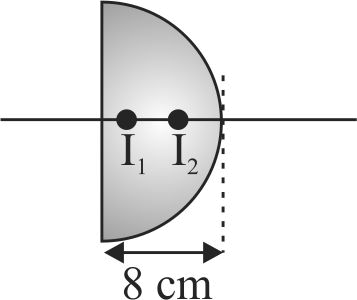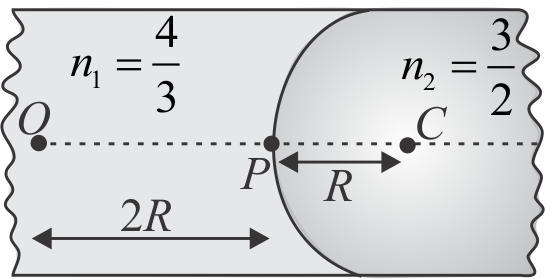364799
A plastic hemisphere has a radius of curvature of \(8\;cm\) and an index of refraction of 1.6. On the axis halfway between the plane surface and the spherical one ( \(4\;cm\) from each) is a small object \({\rm{O}}\). The distance between the two images when viewed along the axis from the two sides of the hemisphere is approximately
364800
A luminous point object \({O}\) is placed at a distance \({2 R}\) from the spherical boundary separating two transparent media of refractive indices \({n_{1}}\) and \({n_{2}}\) as shown, where \({R}\) is the radius of curvature of the spherical surface. If \({n_{1}=\dfrac{4}{3}, n_{2}=\dfrac{3}{2}}\) and \({R=10 {~cm}}\), the image is obtained at a distance from \({P}\) equal to
364799
A plastic hemisphere has a radius of curvature of \(8\;cm\) and an index of refraction of 1.6. On the axis halfway between the plane surface and the spherical one ( \(4\;cm\) from each) is a small object \({\rm{O}}\). The distance between the two images when viewed along the axis from the two sides of the hemisphere is approximately
364800
A luminous point object \({O}\) is placed at a distance \({2 R}\) from the spherical boundary separating two transparent media of refractive indices \({n_{1}}\) and \({n_{2}}\) as shown, where \({R}\) is the radius of curvature of the spherical surface. If \({n_{1}=\dfrac{4}{3}, n_{2}=\dfrac{3}{2}}\) and \({R=10 {~cm}}\), the image is obtained at a distance from \({P}\) equal to
364799
A plastic hemisphere has a radius of curvature of \(8\;cm\) and an index of refraction of 1.6. On the axis halfway between the plane surface and the spherical one ( \(4\;cm\) from each) is a small object \({\rm{O}}\). The distance between the two images when viewed along the axis from the two sides of the hemisphere is approximately
364800
A luminous point object \({O}\) is placed at a distance \({2 R}\) from the spherical boundary separating two transparent media of refractive indices \({n_{1}}\) and \({n_{2}}\) as shown, where \({R}\) is the radius of curvature of the spherical surface. If \({n_{1}=\dfrac{4}{3}, n_{2}=\dfrac{3}{2}}\) and \({R=10 {~cm}}\), the image is obtained at a distance from \({P}\) equal to
364799
A plastic hemisphere has a radius of curvature of \(8\;cm\) and an index of refraction of 1.6. On the axis halfway between the plane surface and the spherical one ( \(4\;cm\) from each) is a small object \({\rm{O}}\). The distance between the two images when viewed along the axis from the two sides of the hemisphere is approximately
364800
A luminous point object \({O}\) is placed at a distance \({2 R}\) from the spherical boundary separating two transparent media of refractive indices \({n_{1}}\) and \({n_{2}}\) as shown, where \({R}\) is the radius of curvature of the spherical surface. If \({n_{1}=\dfrac{4}{3}, n_{2}=\dfrac{3}{2}}\) and \({R=10 {~cm}}\), the image is obtained at a distance from \({P}\) equal to
